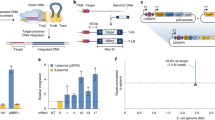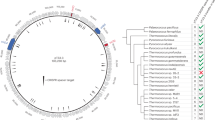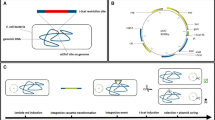Abstract
The mini-Tn7 vectors are universally applicable in Gram-negative bacteria and thereby facilitate the manipulation of many organisms for which few genetic systems are available. These vectors, when provided with only the Tn7 site-specific transposition machinery, insert site and orientation specifically in the bacterial chromosome at an attTn7 site downstream of the essential glmS gene. A few bacteria, including Burkholderia spp., contain multiple glmS genes and therefore several attTn7 sites. Here we provide a protocol for application of the mini-Tn7 system in B. mallei as an example of bacteria with multiple glmS sites. The procedure involves, first, cloning of the genes of interest into an appropriate mini-Tn7 vector; second, co-transfer of the recombinant mini-Tn7 vector and a helper plasmid encoding the Tn7 site-specific transposition pathway into B. mallei by conjugation, followed by selection of insertion-containing strains; and last, PCR verification of mini-Tn7 insertions. B. mallei possesses two glmS genes on chromosome 1 and Tn7 transposes to both sites, although transposition to attTn7-1 associated with glmS1 occurs in more than 90% of the clones examined. Transposition is efficient and the whole procedure from start to verification of insertion events can be done in less than 5 d. This first chromosome integration system in B. mallei provides an important contribution to the genetic tools emerging for Burkholderia spp. Vectors are available for gene complementation and expression, and gene fusion analyses.
This is a preview of subscription content, access via your institution
Access options
Subscribe to this journal
Receive 12 print issues and online access
$259.00 per year
only $21.58 per issue
Buy this article
- Purchase on Springer Link
- Instant access to full article PDF
Prices may be subject to local taxes which are calculated during checkout



Similar content being viewed by others
References
Waag, D.M. & DeShazer, D. Glanders. New insights into an old disease. in Biological Weapons Defense: Infectious Diseases and Counterbioterrorism (eds. Lindler, L.E., Lebeda, F.J. & Korch, G.W.) 209–237 (Humana, Totowa, 2004).
Dance, D.A.B. Melioidosis and glanders as possible biological weapons. in Bioterrorism and Infectious Agents. A New Dilemma for the 21st Century (eds. Fong, W. & Alibek, K.) 99–145 (Springer Science and Business Media, New York, 2005).
Srinivasan, A. et al. Glanders in a military research microbiologist. N. Engl. J. Med. 345, 256–258 (2001).
Nierman, W.C. et al. Structural flexibility in the Burkholderia mallei genome. Proc. Natl. Acad. Sci. USA 101, 14246–14251 (2004).
Choi, K.-H. et al. A Tn7-based broad-range bacterial cloning and expression system. Nat. Methods 2, 443–448 (2005).
Choi, K.-H. & Schweizer, H.P. mini-Tn7 insertion in bacteria with single attTn7 sites: example Pseudomonas aeruginosa. Nat. Protocols 1, 153–161 (2006).
Craig, N.L. Transposon Tn7. Curr. Top. Microbiol. Immunol. 204, 27–48 (1996).
Peters, J.E. & Craig, N.L. Tn7: smarter than we thought. Nat. Rev. Mol. Cell Biol. 2, 806–814 (2001).
Holden, M.T.G. et al. Genomic plasticity of the causative agent of melioidosis, Burkholderia pseudomallei. Proc. Natl. Acad. Sci. USA 101, 14240–14245 (2004).
Yanisch-Perron, C., Vieira, J. & Messing, J. Improved M13 cloning vectors and host strains: nucleotide sequences of the M13mp18 and pUC19 vectors. Gene 33, 103–119 (1985).
Sambrook, J. & Russell, D.W. Molecular Cloning (Cold Spring Harbor Laboratory Press, Cold Spring Harbor, NY, 2001).
Choi, K.-H. & Schweizer, H.P. mini-Tn7 insertion in bacteria with secondary, non-glmS-linked attTn7 sites: example Proteus mirabilis HI4320. Nat. Protocols 1, 170–178 (2006).
Brett, P.J., DeShazer, D. & Woods, D.E. Burkholderia thailandensis sp. nov., a Burkholderia pseudomallei-like species. Int. J. Syst. Bacteriol. 48, 317–320 (1998).
Hoang, T.T., Karkhoff-Schweizer, R.R., Kutchma, A.J. & Schweizer, H.P. A broad-host-range Flp-FRT recombination system for site-specific excision of chromosomally-located DNA sequences: application for isolation of unmarked Pseudomonas aeruginosa mutants. Gene 212, 77–86 (1998).
Schweizer, H.P. Intrinsic resistance to inhibitors of fatty acid biosynthesis in Pseudomonas aeruginosa is due to efflux: application of a novel technique for generation of unmarked chromosomal mutations for the study of efflux systems. Antimicrob. Agents Chemother. 42, 394–398 (1998).
Acknowledgements
This work was supported by Public Health Service grants (AI058141 and AI065357) from the US National Institute of Allergy and Infectious Diseases (NIAID) to H.P.S. B. mallei work at the US Army Medical Research Institute of Infectious Diseases was sponsored by NIAID Interagency Agreement Y1-AI-5004-01. Opinions, interpretations, conclusions and recommendations are those of the authors and not necessarily endorsed by the US Army.
Author information
Authors and Affiliations
Contributions
K.H.C. performed most of the experiments and assisted in writing the manuscript; D.D. performed the B. mallei experiments and proofread the manuscript; H.P.S. supervised the research, designed the experiments and wrote the manuscript.
Corresponding author
Ethics declarations
Competing interests
The authors declare no competing financial interests.
Rights and permissions
About this article
Cite this article
Choi, KH., DeShazer, D. & Schweizer, H. mini-Tn7 insertion in bacteria with multiple glmS-linked attTn7 sites: example Burkholderia mallei ATCC 23344. Nat Protoc 1, 162–169 (2006). https://doi.org/10.1038/nprot.2006.25
Published:
Issue Date:
DOI: https://doi.org/10.1038/nprot.2006.25
This article is cited by
-
Creation of Golden Gate constructs for gene doctoring
BMC Biotechnology (2020)
-
Polar localization of the ATPase ClpV-5 occurs independent of type VI secretion system apparatus proteins in Burkholderia thailandensis
BMC Research Notes (2019)
-
The heritable natural competency trait of Burkholderia pseudomallei in other Burkholderia species through comE and crp
Scientific Reports (2018)
-
Mini-Tn7 vectors for stable expression of diguanylate cyclase PleD* in Gram-negative bacteria
BMC Microbiology (2015)
-
Tn5/7-lux: a versatile tool for the identification and capture of promoters in Gram-negative bacteria
BMC Microbiology (2015)
Comments
By submitting a comment you agree to abide by our Terms and Community Guidelines. If you find something abusive or that does not comply with our terms or guidelines please flag it as inappropriate.



